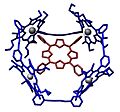Harry Anderson (chemist) facts for kids
Quick facts for kids
Harry Anderson
|
|
|---|---|
 |
|
| Born |
Harry Laurence Anderson
12 January 1964 |
| Nationality | British |
| Alma mater | |
| Known for | Porphyrin Nanorings |
| Scientific career | |
| Fields | Organic chemistry |
| Institutions | |
| Thesis | Model Enzymes Based on Porphyrins (1991) |
| Doctoral advisor | Jeremy Sanders |
| Notable students | Ed Anderson |
Harry Laurence Anderson is a British chemist who works at the University of Oxford. He is famous for creating tiny, complex structures called supramolecular systems. These include porphyrin nanorings and nanowires, which are like super small rings and wires made of molecules. He also studies how these tiny systems behave and even helped make a special carbon ring called cyclo[18]carbon. He is a Professor of Chemistry at Keble College, Oxford.
Contents
Harry Anderson's Early Life and Studies
Harry Anderson studied chemistry at Christ Church, University of Oxford. He earned his first degree there in 1987. After that, he continued his studies at the University of Cambridge. He worked with a professor named Jeremy Sanders and received his advanced degree in 1990.
His Work and Discoveries
Professor Anderson started his own research in 1990. He was a research fellow at Magdalene College, Cambridge until 1993. Then, he moved to ETH-Zürich in Switzerland for a year. In 1994, he returned to the University of Oxford. He became a professor of chemistry there in 2004.
Building Tiny Structures
Nature often uses "templates" to build complex things, like how our bodies make proteins. Scientists like Professor Anderson get ideas from this to create their own tiny structures. He uses small building blocks called porphyrins to make nanorings. These are like tiny rings made of molecules. He can make them in many different sizes and shapes.
These tiny systems are interesting because they can connect with other molecules. This helps scientists understand how similar connections happen in nature.
Vernier Templating
Professor Anderson uses a special method called "Vernier templating." This is like building something big from smaller pieces that don't quite fit perfectly. Imagine you have two gears with different numbers of teeth. If you turn them, they will eventually line up again. In chemistry, this method helps build very large molecular systems. Some of these systems can be as heavy as small proteins.
Working with Other Scientists
Professor Anderson's work in making these tiny structures has led to many collaborations. He works with scientists from different fields around the world. They found that the long, connected systems he built from porphyrins have amazing properties. For example, they can transfer energy or light in new ways. This gives physicists and biologists new ideas for their own research.
Awards and Recognition
Professor Anderson has received many awards for his important work. These awards show how much his contributions to chemistry are valued.
- 2017: Izatt-Christensen Award (for Macrocyclic and Supramolecular Chemistry)
- 2013: Elected a Fellow of the Royal Society. This is a very high honor for scientists in the UK.
- 2008: Merck-Karl Pfister Visiting Professor in Organic Chemistry at MIT, USA
- 2006: RSC Industrially-Sponsored Award for Supramolecular Chemistry
- 2003: Royal Society of Chemistry Award for Materials Chemistry
- 2003: Bob Hay Lecturer (Royal Society of Chemistry, Macrocyclic Chemistry)
- 2001: Corday Morgan Medal and Prize from the Royal Society of Chemistry
- 1995: Nuffield Foundation Award for New Science Lecturers
- 1993: NATO/SERC Research Fellowship
When he was chosen for the Royal Society in 2013, they said he was known for designing and making "supramolecular materials and molecular wires." They also noted his new ideas for building molecules and his work with physicists and photobiologists. This helped them understand how the structure of molecules affects their function.
Images for kids



